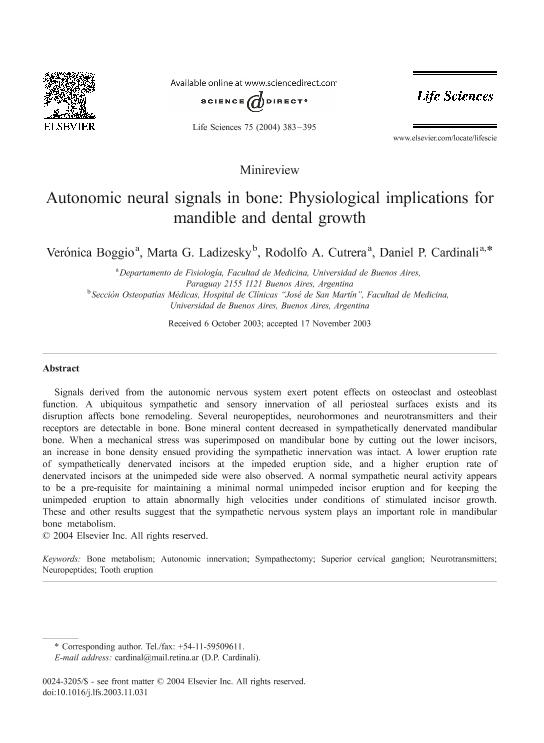Artículo
Autonomic neural signals in bone: Physiological implications for mandible and dental growth
Fecha de publicación:
06/2004
Editorial:
Pergamon-Elsevier Science Ltd
Revista:
Life Sciences
ISSN:
0024-3205
Idioma:
Inglés
Tipo de recurso:
Artículo publicado
Clasificación temática:
Resumen
Signals derived from the autonomic nervous system exert potent effects on osteoclast and osteoblast function. A ubiquitous sympathetic and sensory innervation of all periosteal surfaces exists and its disruption affects bone remodeling. Several neuropeptides, neurohormones and neurotransmitters and their receptors are detectable in bone. Bone mineral content decreased in sympathetically denervated mandibular bone. When a mechanical stress was superimposed on mandibular bone by cutting out the lower incisors, an increase in bone density ensued providing the sympathetic innervation was intact. A lower eruption rate of sympathetically denervated incisors at the impeded eruption side, and a higher eruption rate of denervated incisors at the unimpeded side were also observed. A normal sympathetic neural activity appears to be a pre-requisite for maintaining a minimal normal unimpeded incisor eruption and for keeping the unimpeded eruption to attain abnormally high velocities under conditions of stimulated incisor growth. These and other results suggest that the sympathetic nervous system plays an important role in mandibular bone metabolism.
Archivos asociados
Licencia
Identificadores
Colecciones
Articulos(OCA HOUSSAY)
Articulos de OFICINA DE COORDINACION ADMINISTRATIVA HOUSSAY
Articulos de OFICINA DE COORDINACION ADMINISTRATIVA HOUSSAY
Articulos(SEDE CENTRAL)
Articulos de SEDE CENTRAL
Articulos de SEDE CENTRAL
Citación
Boggio, Veronica Ines; Ladizesky, Marta Graciela; Cutrera, Rodolfo Angel; Cardinali, Daniel Pedro; Autonomic neural signals in bone: Physiological implications for mandible and dental growth; Pergamon-Elsevier Science Ltd; Life Sciences; 75; 4; 6-2004; 383-395
Compartir
Altmétricas




